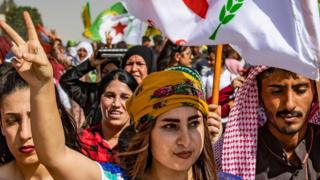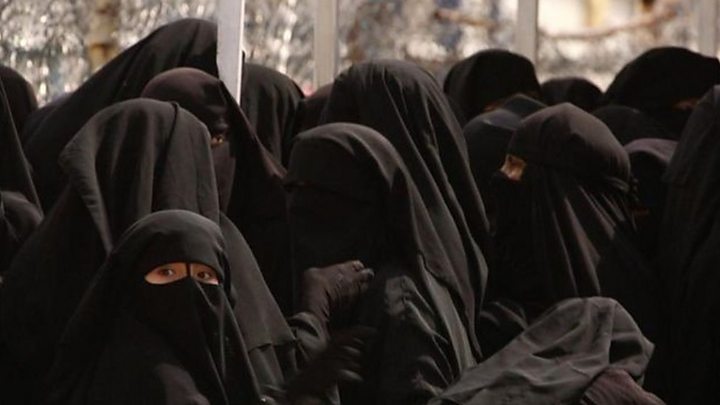Turkey v Syria’s Kurds: The short, medium and long story
A US pullout from north-east Syria has set Turkish and Kurdish fighters on collision course there. …

 Image copyright AFP
Image copyright AFP The Turkish military has launched a major cross-border operation in north-eastern Syria against a Kurdish-led militia alliance allied to the United States.
The move came after US troops, who relied on the militia alliance to defeat the Islamic State (IS) group on the ground in Syria, withdrew from the border area.
We’ve boiled down why it matters.
Why has Turkey launched an assault?
One main reason: Turkey considers the biggest militia in the Kurdish-led alliance a terrorist group. It says it is an extension of a Kurdish rebel group fighting in Turkey.
Turkey’s president wants a 32km (20-mile) deep “safe zone” along the Syrian side of the border clear of Kurdish fighters. He also hopes to resettle up to 2 million Syrian refugees currently living in Turkey there.
The Kurdish-led alliance says it will defend its territory. It accused the US of “leaving the area to turn into a war zone” and risking the re-emergence of IS.
Turkey has vowed to push back from its border members of a Syrian Kurdish militia called the People’s Protection Units (YPG).
Turkish leaders view the YPG as an extension of the banned Kurdistan Workers’ Party (PKK), which has fought for Kurdish autonomy in Turkey for three decades.
The YPG dominates an alliance of Kurdish and Arab militias called the Syrian Democratic Forces (SDF), which has driven IS out of a quarter of Syria over the past four years with the help of air strikes by a US-led coalition.
Turkey has carried out two cross-border offensives against the Kurdish forces.
In early 2018, it attacked the Kurdish enclave of Afrin, in western Syria. Dozens of civilians were killed.
That December, with IS close to defeat, President Donald Trump said the US would begin withdrawing troops from Syria. When commanders and allies expressed concern about the fate of the Kurds, he proposed creating a “20-mile safe zone” along the border.
Mr Trump later suspended the withdrawal, but Turkish President Recep Erdogan continued pressing for a safe zone.
In August, the US and Turkey agreed to establish one together, but called it a “security mechanism”. The YPG complied and began dismantling border fortifications.
But two months later, Mr Erdogan warned Mr Trump that Turkey was going to set up a safe zone alone.
Mr Trump said US troops would withdraw from the border area and that Turkey would be responsible for all IS militants detained by the SDF.
Mr Erdogan is confident his proposed 480km-long corridor will ensure Turkey’s border security and become home to between 1 and 2 million Syrian refugees.
The SDF said it had been “stabbed in the back” by the US, and warned that a Turkish offensive would create a “permanent warzone” and reverse the defeat of IS.
Why is Turkey worried about Syria’s Kurds?
It feels threatened by the People’s Protection Units (YPG), the military wing of the Syrian Kurdish Democratic Union Party (PYD).
The Turkish government insists the YPG is an extension of the Kurdistan Workers’ Party (PKK), which has fought for Kurdish autonomy in Turkey since 1984 and is designated as a terrorist group by the US and EU.
The YPG and PKK share a similar ideology, but they say they are separate entities.
The US also rejects Turkey’s portrayal of the YPG, which has avoided taking sides in Syria’s eight-year-old civil war but been a key ally of the West in the battle against IS.
The YPG is the dominant force in an alliance of Kurdish and Arab militias called the Syrian Democratic Forces (SDF). With the help of air strikes, weapons and advisers from a US-led multinational coalition, SDF fighters captured tens of thousands of square kilometres of territory in north-eastern Syria from IS.
An autonomous administration has been set up in the region, which is home to about 2 million civilians, 650,000 of whom have displaced by fighting elsewhere.
Is this Turkey’s first cross-border operation?
Despite being part of the US-led coalition against IS, Turkey has vehemently opposed supporting the SDF and tried to stop it taking control of Syria’s northern border.
In 2016, the Turkish military supported an offensive by allied Syrian rebel factions that drove IS militants out of the key border town of Jarablus and stopped SDF fighters moving west, towards the Kurdish enclave of Afrin.

Media playback is unsupported on your device
The US dissuaded Turkey from also attempting to take the mainly Arab town of Manbij by force at the time, but Turkish leaders continued to insist that SDF fighters withdraw and it remained a flashpoint.
In January 2018, after US officials said they were helping the SDF build a new “border security force”, Turkish troops and allied Syrian rebels launched an operation to expel YPG fighters from Afrin.
The Syrian Observatory for Human Rights, a UK-based monitoring group, said almost 300 civilians were killed in the eight-week battle, along with 1,500 Kurdish militiamen, 400 pro-Turkish fighters and 45 Turkish soldiers. At least 137,000 civilians were displaced.
What prompted the talk of a “safe zone”?
In December 2018, President Donald Trump declared that IS had been defeated and announced he had ordered the 2,000 US troops helping the SDF in Syria to start withdrawing immediately.
Foreign allies and senior Republicans disputed the claim about IS and expressed concern about what might happen to Kurdish forces without US protection. Days later, Mr Trump tweeted: “Will devastate Turkey economically if they hit Kurds. Create 20 mile safe zone…”
Although the US withdrawal was delayed, Turkish President Recep Erdogan seized on Mr Trump’s proposal and said Turkish forces were ready to set up a safe zone.
The issue returned to the fore after the SDF captured the last pocket of territory held by IS in March 2019.
In an attempt to avert an offensive, the US military agreed in August to set up with the Turkish military a “security mechanism” in the border area. The YPG co-operated and began dismantling fortifications.

Media playback is unsupported on your device
But on 6 October, Turkish President Recep Tayyip Erdogan told Mr Trump a cross-border operation would “soon be moving forward”, the White House said. Mr Trump responded by saying US troops in the area would not support the operation and would withdraw, it added.
The White House also said Turkey would be responsible for all captured IS fighters in the area. The SDF is detaining 12,000 male suspects in makeshift prisons, while 70,000 women and children suspected of links to IS are being held at camps.
What is Turkey proposing to do?
Announcing the start of “Operation Peace Spring” on 9 October, Mr Erdogan said Turkey’s aim was “to prevent the creation of a terror corridor across our southern border, and to bring peace to the area”.
“[We] will neutralize terror threats against Turkey and lead to the establishment of a safe zone, facilitating the return of Syrian refugees to their homes,” he added. “We will preserve Syria’s territorial integrity and liberate local communities from terrorists.”
What do Syria’s Kurds say?
The SDF has said it is determined to defend its territory “at all costs”.
Before the Turkish assault began, SDF commanders warned that north-eastern Syria was “on the edge of a possible humanitarian catastrophe”.
“This attack will spill the blood of thousands of innocent civilians because our border areas are overcrowded,” it added.
The SDF has also said the Turkish operation could pave the way for the re-emergence of IS.
The UN says it has made contingency plans to assist displaced civilians and is “preparing for the worst”.
Mr Trump has threatened to “totally destroy and obliterate” Turkey’s economy if it takes any action he considers “off-limits”.




